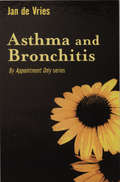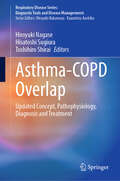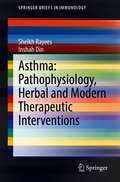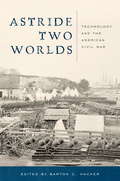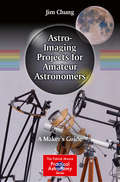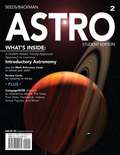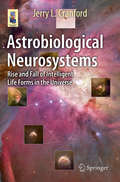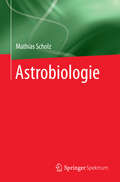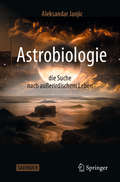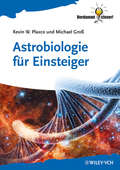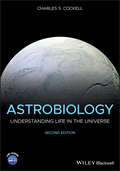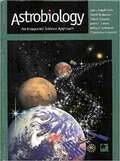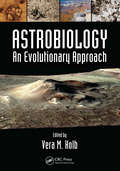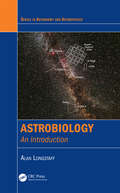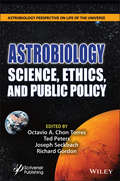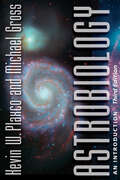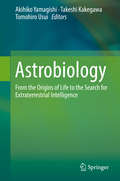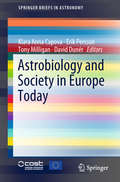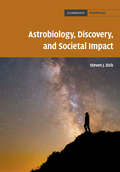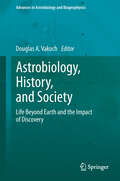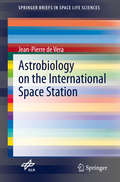- Table View
- List View
Asthma and Bronchitis
by Jan de VriesIt is clear that asthma and bronchitis are on the increase, especially in Britain, and there are strong indications that this rise may be linked to atmospheric influences. Jan de Vries has over 30 years' experience of treating these conditions and in this important title in the By Appointment Only series he sets out his own ideas about respiratory disorders. He shows, for example, how many allergic reactions can result in asthma-related problems, hay-fever being a case in point. Viruses, bacteria and irritants may result in dry coughs, mucus formation, breathlessness, muscle pain and even light fever, depression and sometimes emphysema. Emphysema is known to be incurable, but Jan de Vries shows his treatments can bring welcome relief.
Asthma-COPD Overlap: Updated Concept, Pathophysiology, Diagnosis and Treatment (Respiratory Disease Series: Diagnostic Tools and Disease Managements)
by Hiroyuki Nagase Hisatoshi Sugiura Toshihiro ShiraiThis book elucidates the diagnostic criteria and concept of asthma-COPD overlap (ACO) and provides the latest information on its epidemiology, pathophysiology, diagnostic criteria, and treatment options. It discusses the controversy-causing findings of prognosis of ACO, the novel molecular mechanism including nitrosative stress, radiological or physiological features, findings by research that used HRCT or forced oscillation technique. In addition to a recent animal model of ACO, the role of each biomarker, the latest results of ICS/LAMA/LABA combination inhalers or biologics is also debated. Asthma COPD Overlap -Updated Concept, Pathophysiology, Diagnosis, and Treatment is addressed not only to beginners, but also to physicians engaged in clinical practice, supervisors, and many basic researchers. Covering every aspect of ACO, it serves readers to improve diagnosis or treatment for patients with ACO.
Asthma: Pathophysiology, Herbal and Modern Therapeutic Interventions (SpringerBriefs in Immunology)
by Sheikh Rayees Inshah DinAsthma is a chronic airway disease affecting over 300 million people worldwide with an expected increase of an additional 100 million by 2025. Past decade has observed a notable increase in asthma prevalence on both national and global levels with highest rates observed in western countries (about 30%). Over the past 40 years, a drastic increase in global prevalence, morbidity, mortality, and economic burden have been observed due to asthma especially in children. The rising numbers of hospital admissions for asthma, especially young children, reflect an increase in severe asthma, poverty and lack of proper disease management. Worldwide, approximately 180,000 deaths annually are caused due to this condition. The financial burden on a single asthma patient per year in different western countries ranges from US$300–1,300.Asthma is an intricate respiratory disorder with differences in its severity, natural history and hence treatment response. These differences in intensities of various presentations such as bronchial hyper-responsiveness, airway inflammation, mucus production, airflow obstruction make asthma a heterogeneous disease. The mainstay of current therapies for asthma includes inhaled corticosteroids, phosphodiesterase inhibitors, leukotriene modifiers and β2-adrenoceptor agonists. Some of the currently available drugs are efficient in one or more aspects. However the associated side effects or heterogeneity of the disease limit their usefulness and efficacy, thereby putting a demand on development of new drugs and therapies. On the other hand, asthma has also been treated/managed via herbal medications. These approaches have been described in Unani, Ayurvedic or Chinese system of medicine since antiquity. In fact, several anti-asthmatic drugs were developed from herbs commonly utilized in the non-Western system of medicine.This book focuses on the pathophysiology of asthma, its medication (both herbal and modern), limitations and their future prospects.
Astonishing Nature: Forces of Nature Unit 4
by McGraw-HillHow does Earth change? Earth is constantly changing. Scientists study all parts of what makes our planet survive, thrive, and adapt. It is important for us to know and predict patterns that affect Earth so that we can protect it. It is also important for us to understand the natural forces that affect Earth. The more we know, the more we can do to help preserve our planet.
The Astral Fortress (Tom Swift III, Book #5)
by Victor AppletonFrom the back of the book: Tom, Ben, Kate and Anita fight for their lives when they are captured by the evil industrialist, David Luna, and imprisoned in his massive space fortress. Luna is desperate for the secret of the stardrive that Tom has developed which makes it possible to travel from one galaxy to another in a matter of minutes. When Luna tries to force the stardrive into operation, an accident occurs--hurtling them deep into unknown space. They come upon a dark, swampy planet infested with strange and dangerous beasts. It's up to Tom to save them all from the planet and it's deadly inhabitants!
Astride Two Worlds
by Barton C. HackerBy the middle of the nineteenth century, industrialization and military-technological innovation were beginning to alter drastically the character and conditions of warfare as it had been conducted for centuries. Occurring in the midst of these far-reaching changes, the American Civil War can justly be labeled both the last great preindustrial war and the first major war of the industrial age. Industrial capacity attained new levels of military significance as transportation improved, but in this, as in many other respects, the Civil War was distinctly transitional. Smoothbore artillery still dominated the battlefield, horse-drawn wagons and pack mules still carried the main logistic burden, seamstresses still outnumbered sewing-machine operators. Astride Two Worlds addresses the various causes and consequences of technological change for the course and outcome of the American Civil War.
Astro-Imaging Projects for Amateur Astronomers: A Maker’s Guide (The Patrick Moore Practical Astronomy Series)
by Jim ChungThis is the must-have guide for all amateur astronomers who double as makers, doers, tinkerers, problem-solvers, and inventors. In a world where an amateur astronomy habit can easily run into the many thousands of dollars, it is still possible for practitioners to get high-quality results and equipment on a budget by utilizing DIY techniques. Surprisingly, it's not that hard to modify existing equipment to get new and improved usability from older or outdated technology, creating an end result that can outshine the pricey higher-end tools. All it takes is some elbow grease, a creative and open mind and the help of Chung's hard-won knowledge on building and modifying telescopes and cameras. With this book, it is possible for readers to improve their craft, making their equipment more user friendly. The tools are at hand, and the advice on how to do it is here. Readers will discover a comprehensive presentation of astronomical projects that any amateur on any budget can replicate - projects that utilize leading edge technology and techniques sure to invigorate the experts and elevate the less experienced. As the "maker" community continues to expand, it has wonderful things to offer amateur astronomers with a willingness to get their hands dirty. Tweaking observing and imaging equipment so that it serves a custom purpose can take your observing options to the next level, while being fun to boot.
Astro2
by Michael A. Seeds Dana BackmanCreated through a "student-tested, faculty-approved" review process, ASTRO 2e is an engaging and accessible solution to accommodate the diverse lifestyles of today's learners. ASTRO 2e employs the same engaging writing style that has become a hallmark of Mike Seeds and Dana Backman's introductory astronomy texts.
The Astrobiological Landscape
by Milan M. ĆirkovićAstrobiology is an expanding, interdisciplinary field investigating the origin, evolution and future of life in the universe. Tackling many of the foundational debates of the subject, from discussions of cosmological evolution to detailed reviews of common concepts such as the 'Rare Earth' hypothesis, this volume is the first systematic survey of the philosophical aspects and conundrums in the study of cosmic life. The author's exploration of the increasing number of cross-over problems highlights the relationship between astrobiology and cosmology and presents some of the challenges of multidisciplinary study. Modern physical theories dealing with the multiverse add a further dimension to the debate. With a selection of beautifully presented illustrations and a strong emphasis on constructing a unified methodology across disciplines, this book will appeal to graduate students and specialists who seek to rectify the fragmented nature of current astrobiological endeavour, as well as curious astrophysicists, biologists and SETI enthusiasts.
Astrobiological Neurosystems: Rise and Fall of Intelligent Life Forms in the Universe (Astronomers' Universe)
by Jerry L. CranfordThis book explains why scientists believe that life may be more common in the Universe than previously considered possible. It presents the tools and strategies astronomers and astrobiologists are using in their formal search for habitable exoplanets as well as more advanced forms of life in other parts of our galaxy. The author then summarizes what is currently known about how and where organic molecules critical to our form of carbon-based life are manufactured. The core of the book explains (and presents educated guesses) how nervous systems evolved on Earth, how they work, and how they might work on other worlds. Combining his knowledge of neuroscience, computers, and astrobiology the author jumps into the discussion whether biological nervous systems are just the first step in the rise of intelligence in the Universe. The book ends with a description from both the psychologist's and the neuroscientist's viewpoints, exactly what it is about the fields of astrobiology and astronomy that "boggles the minds" of many amateur astronomers and interested non-scientists. This book stands out from other popular science books on astrobiology by making the point that "astro-neurobiologists" need to begin thinking about how alien nervous systems might work.
Astrobiologie
by Mathias ScholzUnter welchen Bedingungen entsteht ,,Leben" und wie ist es im Kosmos verbreitet? Damit beschäftigt sich der Autor und stellt wichtige Facetten einer jungen Wissenschaftsdisziplin ausführlich vor: · Was ist und wie funktioniert ,,Leben"? · Entstehung des Lebens auf der Erde · Kosmische Voraussetzungen für ,,Leben, wie wir es kennen" · Leben im Sonnensystem und darüber hinaus · Suche nach außerirdischen Zivilisationen Zudem wird das spannende Gebiet der Astrochemie behandelt, welches erklärt wie sich die molekularen Grundbausteine des Lebens unter kosmischen Bedingungen bilden. Das Buch wendet sich an interessierte Studenten der Natur- und Ingenieurwissenschaften, Abiturienten, Dozenten, Lehrer und nicht zuletzt an Amateurastronomen.
Astrobiologie - die Suche nach außerirdischem Leben
by Aleksandar Janjic"Wie können wir in diesem Jahrhundert außeridisches Leben endgültig nachweisen? Sollte es Leben in unserem Sonnensystem geben, wird es in diesem Jahrhundert gefunden werden. Mit diesem Buch wird dem Leser der aktuellste Stand der Astrobiologie verständlich vermittelt und über die heutigen und anstehenden Missionen der Raumfahrtbehörden berichtet. Kommen Sie mit auf die Reise von der Entstehung des Lebens, über die Möglichkeiten von Leben in unserem Sonnensystem, bis hin zu Exoplaneten und fernen erdähnlichen Welten, um das Phänomen des Lebens als planetaren Prozess verstehen zu können.
Astrobiologie für Einsteiger (Verdammt clever!)
by Kevin W. Plaxco Michael GroßNach einem einführenden Kapitel über die Definition von Leben beginnt die Erkundung des Themas »Leben im Universum« mit der Geschichte des Universums, unter besonderer Berücksichtigung der Umstände, die die Entwicklung von Leben ermöglicht haben. Es fokussiert dann in ähnlicher Weise auf die Geschichte unseres Sonnensystems und der Erde. Im mittleren Teil des Buchs geht es um das Leben auf der Erde: wie konnte es entstehen, sich ausbreiten, und mehr als drei Milliarden Jahre lang überleben? Welche seiner Eigenschaften sind Zufall, und welche Notwendigkeit? Im letzten Drittel des Buchs werden die Erkenntnisse aus der irdischen Biologie angewandt auf die Suche nach Leben im übrigen Sonnensystem (Mars, Monde des Jupiter und Saturn) und nach lebensfreundlichen Planeten im Rest des Universums.
Astrobiology: Understanding Life in the Universe (Physical Chemistry In Action Ser.)
by Charles S. CockellA guide to understanding the formation of life in the Universe The revised and updated second edition of Astrobiology offers an introductory text that explores the structure of living things, the formation of the elements required for life in the Universe, the biological and geological history of the Earth, and the habitability of other planets. Written by a noted expert on the topic, the book examines many of the major conceptual foundations in astrobiology, which cover a diversity of traditional fields including chemistry, biology, geosciences, physics, and astronomy. The book explores many profound questions such as: How did life originate on Earth? How has life persisted on Earth for over three billion years? Is there life elsewhere in the Universe? What is the future of life on Earth? Astrobiology is centered on investigating the past and future of life on Earth by looking beyond Earth to get the answers. Astrobiology links the diverse scientific fields needed to understand life on our own planet and, potentially, life beyond. This new second edition: Expands on information about the nature of astrobiology and why it is useful Contains a new chapter “What is Life?” that explores the history of attempts to understand life Contains 20% more material on the astrobiology of Mars, icy moons, the structure of life, and the habitability of planets New ‘Discussion Boxes’ to stimulate debate and thought about key questions in astrobiology New review and reflection questions for each chapter to aid learning New boxes describing the careers of astrobiologists and how they got into the subject Offers revised and updated information throughout to reflect the latest advances in the field Written for students of life sciences, physics, astronomy and related disciplines, the updated edition of Astrobiology is an essential introductory text that includes recent advances to this dynamic field.
Astrobiology: An Integrated Science Approach
by Jodi E. Asbell-Clarke Daniel W. Barstow Teon E. Edwards James L. Larsen [et al.]Astrobiology: An Integrated Science Approach
Astrobiology: An Evolutionary Approach (Series in Astrobiology)
by Vera M. KolbAstrobiology: An Evolutionary Approach provides a full course in astrobiology with an emphasis on abiogenesis and evolution. The book presents astrobiology both as a developing science and as the science of the future.The origins of life and the possibility of life elsewhere continues to be a subject of scientific and philosophical examination. The
Astrobiology: An Introduction (Series in Astronomy and Astrophysics)
by Alan LongstaffAstrobiology is a multidisciplinary pursuit that in various guises encompasses astronomy, chemistry, planetary and Earth sciences, and biology. It relies on mathematical, statistical, and computer modeling for theory, and space science, engineering, and computing to implement observational and experimental work. Consequently, when studying astrobio
Astrobiology: Science, Ethics, and Public Policy (Astrobiology Perspectives on Life in the Universe #19)
by Octavio Alfonso Chon Torres Ted Peters Joseph Seckbach Richard GordonASTROBIOLOGY This unique book advances the frontier discussion of a wide spectrum of astrobiological issues on scientific advances, space ethics, social impact, religious meaning, and public policy formulation. Astrobiology is an exploding discipline in which not only the natural sciences, but also the social sciences and humanities converge. Astrobiology: Science, Ethics, and Public Policy is a multidisciplinary book that presents different perspectives and points of view by its contributing specialists. Epistemological, moral and political issues arising from astrobiology, convey the complexity of challenges posed by the search for life elsewhere in the universe. We ask: if a convoy of colonists from Earth make the trip to Mars, should their genomes be edited to adapt to the Red Planet’s environment? If scientists discover a biosphere with microbial life within our solar system, will it possess intrinsic value or merely utilitarian value? If astronomers discover an intelligent civilization on an exoplanet elsewhere in the Milky Way, what would be humanity’s moral responsibility: to protect Earth from an existential threat? To treat other intelligences with dignity? To exploit through interstellar commerce? To conquer? Audience The book will attract readers from a wide range of interests including astronomers, astrobiologists, chemists, biologists, space engineers, ethicists, theologians and philosophers.
Astrobiology: An Introduction
by Kevin W. Plaxco Michael GrossExploring the potential for extraterrestrial life and the origins of our own planet, this comprehensive introduction to astrobiology is updated with the latest findings.Informed by the discoveries and analyses of extrasolar planets and the findings from recent robotic missions across the solar system, scientists are rapidly replacing centuries of speculation about potential extraterrestrial habitats with real knowledge about the possibility of life outside our own biosphere—if it exists, and, if so, where. Casting new light on the biggest questions there are—how did we get here, and who else might be out there?—this third edition of Kevin W. Plaxco and Michael Gross's widely acclaimed Astrobiology incorporates a decade's worth of new developments in space to bring readers the most comprehensive, up-to-date, and engaging introduction to the field available.Plaxco and Gross examine the factors that make our Universe habitable, from the origin of chemical elements and the formation of the first galaxies and stars to the birth and composition of the planets. They describe the latest thinking about the origins of life, explain the evolution of metabolism and the development of complex organisms. In order to assess the limits for life elsewhere, they also explore life in extreme habitats and reveal how it informs the search for potential extraterrestrial habitats—ones that might support extraterrestrial life. New and updated illustrations enhance the book throughout.Sharing fascinating findings from the comet mission Dawn, the visit of New Horizons to Pluto, and the work of the Deep Carbon Observatory, which has revealed an incredible underground biosphere within our own planet, Plaxco and Gross weave together cosmology, astrophysics, geology, biochemistry, biophysics, and microbiology. From neutron star mergers to the survival skills of tardigrades, this fascinating book is an ideal primer for students or anyone curious about life and the Universe.
Astrobiology: From the Origins of Life to the Search for Extraterrestrial Intelligence
by Akihiko Yamagishi Takeshi Kakegawa Tomohiro UsuiThis book provides concise and cutting-edge reviews in astrobiology, a young and still emerging multidisciplinary field of science that addresses the fundamental questions of how life originated and diversified on Earth, whether life exists beyond Earth, and what is the future for life on Earth. Readers will find coverage of the latest understanding of a wide range of fascinating topics, including, for example, solar system formation, the origins of life, the history of Earth as revealed by geology, the evolution of intelligence on Earth, the implications of genome data, insights from extremophile research, and the possible existence of life on other planets within and beyond the solar system. Each chapter contains a brief summary of the current status of the topic under discussion, sufficient references to enable more detailed study, and descriptions of recent findings and forthcoming missions or anticipated research. Written by leading experts in astronomy, planetary science, geoscience, chemistry, biology, and physics, this insightful and thought-provoking book will appeal to all students and scientists who are interested in life and space.
Astrobiology and Cuatro Ciénegas Basin as an Analog of Early Earth (Cuatro Ciénegas Basin: An Endangered Hyperdiverse Oasis)
by Valeria Souza Antígona Segura Jamie S. FosterAstrobiology not only investigates how early life took hold of our planet but also life on other planets – both in our Solar System and beyond – and their potential for habitability. The book take readers from the scars on planetary surfaces made by space rocks to the history of the Solar System narrated by those space rocks as well as exoplanets in other planetary systems. But the true question is how life arose here or elsewhere. Modern comparative genomics has revealed that Darwin was correct; a set of highly conserved genes and cellular functions indicate that all life is related by common ancestry. The Last Universal Common Ancestor or LUCA sits at the base of the Tree of Life. However, once that life took hold, it started to diversify and form complex microbial communities that are known as microbial mats and stromatolites. Due to their long evolutionary history and abundance on modern Earth, research on the biological, chemical and geological processes of stromatolite formation has provided important insights into the field of astrobiology. Many of these microbialite-containing ecosystems have been used as models for astrobiology, and NASA mission analogs including Shark Bay, Pavilion and Kelly Lakes. Modern microbialites represent natural laboratories to study primordial ecosystems and provide proxies for how life could evolve on other planets. However, few viral metagenomic studies (i.e., viromes) have been conducted in microbialites, which are not only an important part of the community but also mirror its biodiversity.This book focuses on particularly interesting sites such as Andean lake microbialites, a proxy of early life since they are characterized by very high UV light, while Alchichica and Bacalar lakes are characterized by high-salt and oligotrophic waters that nurture stromatolites. However, it is only the oasis of Cuatro Ciénegas Basin in México that stored past life in its marine sediments of the Sierra de San Marcos. This particular Sierra has a magmatic pouch that moves the deep aquifer to the surface in a cycle of sun drenched life and back to the depths of the magmatic life in an ancient cycle that now is broken by the overexploitation of the surface water as well as the deep aquifer in order to irrigate alfalfa in the desert. The anthropocene, the era of human folly, is killing this unique time machine and with it the memory of the planet.
Astrobiology and Society in Europe Today (SpringerBriefs in Astronomy)
by David Dunér Tony Milligan Erik Persson Klara Anna CapovaThis White Paper describes the state of astrobiology in Europe today and its relation to the European society at large. With contributions from authors in twenty countries and over thirty scientific institutions worldwide, the document illustrates the societal implications of astrobiology and the positive contribution that astrobiology can make to European society. The White paper has two main objectives: 1. It recommends the establishment of a European Astrobiology Institute (EAI) as an answer to a series of challenges relating to astrobiology but also European research, education and the society at large. 2. It also acknowledges the societal implications of astrobiology, and thus the role of the social sciences and humanities in optimizing the positive contribution that astrobiology can make to the lives of the people of Europe and the challenges they face.This book is recommended reading for science policy makers, the interested public, and the astrobiology community.
Astrobiology, Discovery, and Societal Impact (Cambridge Astrobiology #9)
by Steven J. DickThe search for life in the universe, once the stuff of science fiction, is now a robust worldwide research program with a well-defined roadmap probing both scientific and societal issues.<P> <P>This volume examines the humanistic aspects of astrobiology, systematically discussing the approaches, critical issues, and implications of discovering life beyond Earth. What do the concepts of life and intelligence, culture and civilization, technology and communication mean in a cosmic context? What are the theological and philosophical implications if we find life - and if we do not? <P>Steven J. Dick argues that given recent scientific findings, the discovery of life in some form beyond Earth is likely and so we need to study the possible impacts of such a discovery and formulate policies to deal with them. The remarkable and often surprising results are presented here in a form accessible to disciplines across the sciences, social sciences, and humanities.<P> Explores the humanistic aspects of the discovery of extraterrestrial life, making use of philosophy, science, theology, anthropology, history, and science fiction.<P> This subject is one of the most popular themes in astronomy, and this volume is accessible to a broad audience, including students of humanities, social, and natural sciences, and the interested general reader.<P> Offers the first systematic view of the impact of discovering life beyond Earth, including controversial subjects such as METI (Messaging Extraterrestrial Intelligence)<P> Presents a coherent case of what the implications of finding life might be and why we should tackle them now.
Astrobiology, History, and Society: Life Beyond Earth and the Impact of Discovery (Advances in Astrobiology and Biogeophysics)
by Douglas A. VakochThis book addresses important current and historical topics in astrobiology and the search for life beyond Earth, including the search for extraterrestrial intelligence (SETI). The first section covers the plurality of worlds debate from antiquity through the nineteenth century, while section two covers the extraterrestrial life debate from the twentieth century to the present. The final section examines the societal impact of discovering life beyond Earth, including both cultural and religious dimensions. Throughout the book, authors draw links between their own chapters and those of other contributors, emphasizing the interconnections between the various strands of the history and societal impact of the search for extraterrestrial life. The chapters are all written by internationally recognized experts and are carefully edited by Douglas Vakoch, professor of clinical psychology at the California Institute of Integral Studies and Director of Interstellar Message Composition at the SETI Institute. This interdisciplinary book will benefit everybody trying to understand the meaning of astrobiology and SETI for our human society.
Astrobiology on the International Space Station (SpringerBriefs in Space Life Sciences)
by Jean-Pierre de VeraThis volume on astrobiology of the Springer Briefs in Life Sciences book series addresses the three fundamental questions on origin, evolution, distribution and future of life in the universe: how does life begin and evolve? Is there life beyond Earth and, if so, how can we detect it? What is the future of life on Earth and in the universe? The book provides insights into astrobiological experiments that are being performed on the International Space Station, ISS, and discusses their findings.This extremely exciting volume on astrobiology is intended for scientists of various research fields and for laypersons interested in space research and in the fundamental issues of the universe and life.
